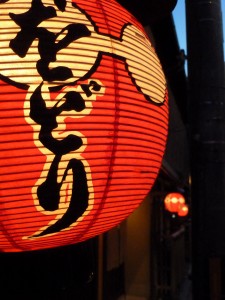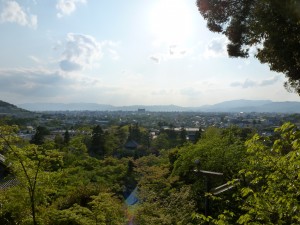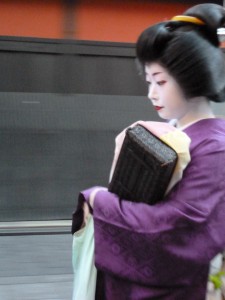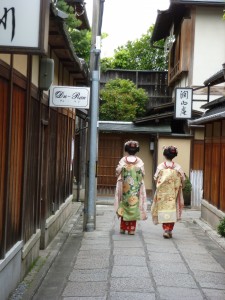Kyoto is probably best known, in the minds of tourists at least, as the haven for Geisha – that mysterious, unknown, misunderstood part of Japanese history and culture. That Kyoto was also the first capital of Japan is a second known fact, glazed over in the guide books by the search for where to catch a glimpse of these decorated women.
Our Ryoken, the first of two places we would be staying at here, is located in a tiny alley – which is a market by day – and is only about a 10 minute walk from Gion.
If Kyoto is known for Geisha, Gion is the apex.
Sprawling Kyoto prefecture
Strolling through Gion is like stepping back into time. The buildings here are still wooden, the streets are impossibly small (yet cars and motorbikes still find a way through), and lanterns are still used to not only illuminate store and restaurant stoops, but to also light the streets.
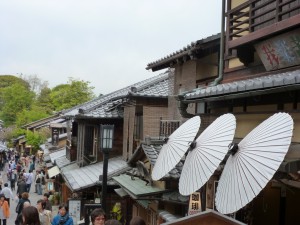
We noticed a throng of tourists milling around outside a particularly large building. We assumed they were waiting for a bus or a tour guide when it happened.
Like a flash a stark white face, bent to the ground, rushed out of a doorway and, almost floating, rushed into the next doorway. It happened in the space of about three minutes.
But that was enough.
The tourists were alive, swarming like bees, flashes were going off everywhere as the people moved into her path, impossibly close. Impolitely close. To snap a picture of her.
It was like a scene you expect in California as a movie star leaves their hotel.
And it made me uncomfortable.
I felt irritated at the tourists. I felt angered on her behalf that her space and privacy was so invaded.
And I questioned my own motives for being here. Aren’t I participating in this same cycle? Drawn to this place in some way due to the mystery of these women? Making a piece of Japanese culture a commodity to be photographed?
I realized the similarities between photographing a shrine, the people participating in these rituals, and photographing a Geisha.
But I also recognized the difference in the amount of disruption caused by taking photographs and capturing life versus this. Capturing a person rather than a moment.
At least that’s how I’m justifying it to myself.
I only took one picture, from a distance, my lens so zoomed in I almost lost her in the frame. I refused to participate in the zoo like scene and jump into her way.
It makes me sad that this was a pivotal moment for me. Something I was so eager to see. Her face seems to say it all. It’s strained, eager for a way out of the throngs of people who want her picture. Grateful that she only has a few steps to go before she’s allowed some privacy.
I guess I had expected something different. Catching glimpses of Geisha around corners going about their daily business.
That’s when we realized that tourists dress up as Geisha too.
How to spot the difference?
A real Geisha or Meiko (geisha in training) will be rushing from one tiny door to the next, barely spotted. She could also be surrounded by people walking with her (there will always be several men around her…I’m starting to think for her protection from the tourists).
A tourist Meiko will be surrounded by no-one. She will smile and mill around. She will certainly have a camera with her and be taking pictures of herself and of her companion.
From the back, especially to the untrained eye such as my own, it was still pretty cool to see the tourist Geisha walking around the tiny alleyways completely free of other camera wielding tourists. And I can imagine what it might have been like in Gion many years ago.
